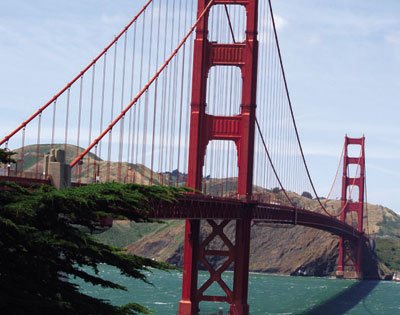On May 26 last year, I spent an hour or so walking across the
mile-long span of the Golden Gate Bridge and back. I suffer from a
mild case of acrophobia and I thought the afternoon jaunt would
help me overcome my irrational fear of heights.
On May 26 last year, I spent an hour or so walking across the mile-long span of the Golden Gate Bridge and back. I suffer from a mild case of acrophobia and I thought the afternoon jaunt would help me overcome my irrational fear of heights.
When I started at the bridge’s San Francisco side, it didn’t seem so bad. A breeze from the Pacific blew in my face as I strode along.
But then, through a gap in the sidewalk, I looked down at the historic Fort Point underneath the bridge. That’s when the terror gripped me. My stomach churned and I felt myself frozen in my sudden panic. A dropping sensation went through me. I felt like Scottie Ferguson, the acrophobic detective played by Jimmy Stewart in Alfred Hitchcock’s “Vertigo” (a 1958 movie with a South Valley connection involving two scenes filmed in San Juan Bautista). In one scene in Hitchcock’s flick, Scottie first meets Madeleine when she tries commit suicide by jumping into the ocean at Fort Point – the bridge looming in the background.
Maybe I was getting a bit over dramatic with my terror. The other tourists had no fear. One girl even stood by the edge peering over the railing and snapping a picture. If she could deal with the height, so could I.
I continued my walk by holding tight to the railing barricade that separates the pedestrian walk from the bridge’s vehicle traffic. I tried to get my mind off my anxiety by thinking of trivia about the bridge.
The main man behind the bridge’s creation was Joseph Strauss, a campaigner for the project. After four years of construction, his dream was realized when the bridge opened May 27, 1937 to a procession of pedestrians. It got its name not from its vibrant paint color – called “International Orange” – but from the Golden Gate Strait that spans from the city of San Francisco to the Marina headlands. American explorer John C. Fremont gave the strait its poetic name in 1846 after a harbor in Istanbul called Chrysocera – “Golden Horn” – that, to his mind, the Golden Gate resembled.
A blast of wind hit me from the Pacific side. Imagining myself – all 200 pounds of me – being hurled by the gust over the edge, I gripped hard on the railing and froze. Around me, tourists continued snapping photos of each other with the city in the background. How could they be so oblivious of their imminent peril, I wondered. I felt the slight sway of the suspension bridge, which is engineered to swing in strong winds to alleviate stresses.
Somehow, I overcame my acrophobia enough to make it to the Golden Gate Bridge’s south tower. I crept around the pedestrian base of it, not daring to go near the edge. Located here was a bronze plaque commemorating people involved with the bridge’s construction and design.
Interestingly, the man who did the most in planning the bridge is not mentioned. Charles Ellis was an engineering expert hired by Joseph Strauss to work out the details of the bridge’s design. He poured his genius into the project, spending countless hours – in an era before digital computers – calculating out with his pencil all the intricate components of the bridge.
His boss, unfortunately, was a jealous man who sought all the glory for himself. After Ellis finished the design, Strauss fired his primary engineer without cause. Ellis never personally saw his creation. He died in 1949, a dozen years after its completion. Although the Golden Gate Bridge became the iconic symbol of the West Coast – and was declared by the American Society of Engineers “one of the modern Wonders of the World” – his major contribution to the project was virtually forgotten by everyone.
That situation, however, is changing with the bridge’s 70th birthday bash on Sunday. After years of reluctance to give Ellis the recognition he deserved, the bridge district this week officially acknowledged the engineer’s major role in the design.
The Golden Gate Bridge is not just a marvel of engineering, it’s a magnificent work of art. And it’s also a testament to the courage of the engineers and workers who built it.
But I wasn’t really thinking about that as I finished my stroll over the bridge and made my way back across. Somehow, I managed my acrophobia enough to return to the San Francisco side where I popped into the bridge’s gift shop. There I bought myself a cheesy tourist T-shirt that proclaimed: “I Walked the Golden Gate Bridge.”














